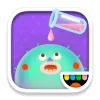Take a look inside 5 images
Toca Lab: Elements
Pros: Cute graphics and interactive tools, combined with open-ended gameplay, make this an excellent way to introduce kids to the elements and encourage them to explore at their own pace.
Cons: The chemical interactions aren't 100% accurate, and the open play approach may not work well with kids who thrive on structured learning.
Bottom Line: The game is a fun introduction to chemistry and the elements, but kids won't learn detailed scientific information.
You could use Toca Lab to supplement early-elementary science units, or as a way to boost kids' interest in chemistry. With the free-play experiments, it's easy to have kids work together to explore the elements. Let kids use the app in small groups for a set amount of time, and then come together as a class to discuss their observations. Ask questions about the tools they used and what kinds of changes they observed after using the tools. Show kids a periodic table, so they can see the scientific names of the elements. Extend the discussion by asking kids to share what they know about common substances and their properties.
At the home screen, kids tap an arrow to enter the virtual lab. Here, kids start experimenting with an element, which is represented by a cute blob-like character. Kids can use different lab equipment, including a centrifuge, Bunsen burner, oscilloscope, test tubes, and cooling agents. As the element changes, the blob's facial expression changes, too. An arrow in the top left corner of the screen changes from red to green when the element can't be changed any further. Once they're finished using one tool, kids can tap the home icon to return to the lab and choose another tool. As kids continue to experiment, the periodic table fills with more elements.
Toca Lab gives kids a fun and gentle introduction to chemistry. Since gameplay is open-ended, you won't see definitive progress from easy to difficult. However, kids can get an idea of how much experimenting they have done since the periodic table fills with elements the more kids experiment. The game is intended for ages 6-8, which is a perfect age range for free-play learning when it comes to chemistry. Kids are empowered to explore and investigate at their own pace, which is a great way to get them excited about science. Some kids do need a more structured learning environment, so an option to explore the elements in a more factual, concrete setting would be a nice addition.













